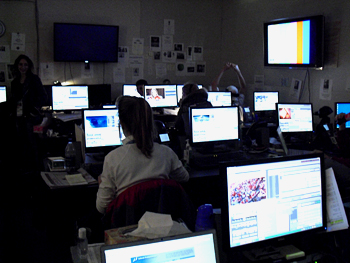NBC: Servers for Broadcast and New Media Production
EVS Delivers in VancouverServers Maximize Vancouver Games Broadcast
Slo-Mos and XMOs in Vancouver
File Transfers Key in ONC Workflow
NBC: Servers for Broadcast and New Media Production
ARD, ZDF Tackle Tapeless, HD in Vancouver
NAB Workshops on Vancouver Games, FIFA World Cup
At the facility of U.S. rights-holder NBC, servers have moved in to the broadcast workflow steadily over the years. In Vancouver, they even became the backbone of a fast-turnaround, production-intensive new media workflow for the first time.
The broadcaster created a lot of programming from the Winter Games — 835 hours of highly edited traditional broadcast content, 450 hours of live streaming, and an amazing 1,500 video clips intended for final delivery on the web or other digital outlets, such as iTunes and mobile phones.
Servers were not just helpful in turning around this content in a hurry, in an environment where staffing levels are always under scrutiny, they are essential.
In Vancouver, the NBC Games crew deployed some 50 EVS servers — mostly XT[2]s — at its IBC facility and at key venues, along with 360 TB of Omneon MediaGrid storage between Vancouver and New York. These servers and the networking, search and transfer of content they allow helped a smaller crew keep pushing the production envelope.
The broadcast production workflow relied mostly on EVS XT[2] servers, from ingest through to sending requested clips over to an Avid ISIS storage array for craft editing, and back to an XT[2] for playout.
David Mazza, senior vice president of engineering for NBC Olympics, stressed that the benefits of servers go beyond the fundamental non-linear nature of the medium.

Some of the XT[2]s dedicated to Highlights Factory ingest and production.

Highlights Factory editors — also known as shot selectors — used IPDirector stations to rapidly make simple playlists for quick clip creation. “I think our production teams use server-based content more for the networking than any other reason,” said Mazza. “With servers the instant access is great, but what they use even more is the networking of clips back and forth ... moving a clip to the archive, moving a clip to another machine if you’re moving edit sessions, so the networking between severs is a huge bonus and they’ve really come to rely on it now.”
EVS’s supporting product range beyond server hardware was also ubiquitous in Vancouver. The main example was IPDirector computer stations — integrated PCs that had a video input and serial control board, and ran EVS IPDirector software. The stations solve a basic problem in any high-volume environment: keeping track of and accessing ingested content. It allowed users to index and search the contents of all the XT[2] and other servers as well as nearline storage devices.
More than 50 IPDirector stations could be found throughout the main facility and venues, deployed by an eclectic group of users. “Interns use it in the Highlights Factory editing, all the way up to the main playout operators and AD’s, who search and catalog with it,” said Mazza. “And the writers even have an IPDirector so as a piece comes in to the tape room, the writers can call it up and write the lead for Bob Costas to lead out to the figure skating piece, for example.”
New Media Workflow

An array of servers — mostly XT[2]s — helped the NBC crew push the production envelope. IPDirector was also a key supporting product in NBC’s Vancouver “Highlights Factory,” the name given to the busy group of interns and supervisors who did the rapid-turnaround clips production that allowed the network’s New Media production to exceed expectations. The HLF produced 1,500 packages for the Web, iTunes, Amazon.com, VOD, mobile phone video, etc. during the Games.
The Vancouver HLFstaff dealt directly with the output from one of nine EVS XT [2]s, servers that were dedicated to new media and distinct from the 40-plus EVS units in the IBC and at the venues. Seven of these nine servers were recording host material full time and the remaining two were located in dedicated Highlights Factory edit suites, although even these had a record channel available for high volume days.
Although many of the clips production relied in IPDirector’s basic cuts editing capability, some pieces required an edit room and a level of finish available with either EVS’s IP Edit software, or even a full Avid setup.
Approved clips were then sent to the Vancouver Omneon MediaGrid for transcoding and transfer via Omneon’s ProXchange file transfer acceleration to a second MediaGrid in New York. From ingest in Vancouver, through editing, to transfer back to New York for conversion into a variety of digital deliverables, NBC’s Vancouver new media production was likely one of the biggest file-based outputs ever.
Deeper in the edit room

XT[2] servers gave NBC’s linear edit suites a bit of non-linear functionality. A decade ago, servers managed the slo-mo recordings in the trucks, and saw use for live-turnaround time shifting applications. Ten years later, servers are used for ingest and playout, and most of the production steps between. Really in just the last four years the XT[2]s have become the primary way NBC captures incoming feeds and gets them into the post production workflow.
The XT[2] servers have even crept into the few remaining linear edit suites NBC keeps at its Games facility, which are used for situations where an experienced editor can rapidly turn around a program. Here, the servers have replaced tape machines, giving the suites a bit of non-linear functionality. If a producer knows there’s some point in a near-finished product that needs a change, it can be pulled up in a non-linear fashion.
Get the TV Tech Newsletter
The professional video industry's #1 source for news, trends and product and tech information. Sign up below.
